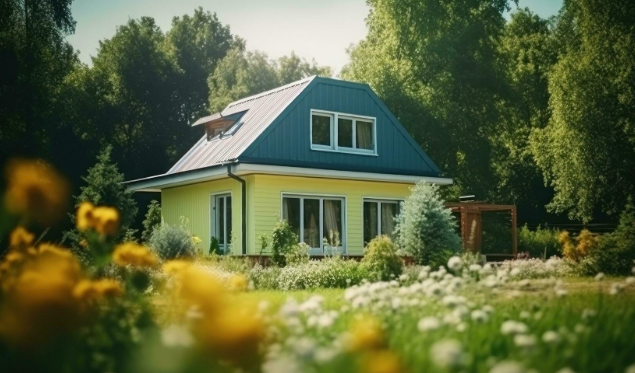In a world of excess and consumerism, many individuals are embracing minimalism as a way to simplify their lives and reduce their environmental footprint. This lifestyle shift has given rise to the tiny home movement, where homeowners are choosing to downsize and live in compact, sustainable dwellings. Tiny homes offer the promise of a clutter-free and eco-friendly lifestyle, appealing to those seeking financial freedom and a closer connection to the essentials of life. In this comprehensive guide, we will explore the rise of tiny homes in the real estate market, their unique benefits, and why this minimalist lifestyle is gaining traction worldwide.
Understanding Tiny Homes
Tiny homes, also known as micro homes or mini houses, are small dwellings typically ranging from 100 to 400 square feet. They are designed to maximize space efficiency and minimize environmental impact. While tiny homes come in various forms and styles, they all share the common goal of promoting simple living and sustainability.
The Rise of Tiny Homes
Financial Freedom
Tiny homes offer an affordable housing option for those looking to reduce their living expenses and achieve financial freedom. With lower upfront costs and minimal ongoing expenses, homeowners can save money and focus on other priorities.
Environmental Consciousness
The compact size of tiny homes means they require fewer resources to build and maintain, leading to a smaller environmental footprint. Many tiny homes are also designed with eco-friendly materials and energy-efficient features.
Minimalist Lifestyle
Living in a tiny home encourages a minimalist lifestyle, promoting the decluttering of possessions and prioritizing experiences and relationships over material possessions.
Mobility and Flexibility
Tiny homes on wheels, known as “tiny houses on wheels” or THOWs, offer the flexibility to move and explore different locations without giving up the comforts of home.
Customization and Personalization
Despite their small size, tiny homes can be highly customizable to suit the homeowner’s preferences and needs. Creative use of space allows for unique and personalized living spaces.
Off-Grid Living
Many tiny homes are equipped with solar panels, composting toilets, and rainwater harvesting systems, enabling off-grid living and greater self-sufficiency.
Key Features of Tiny Homes
Multi-Functional Furniture
Tiny homes often incorporate multi-functional furniture, such as foldable tables, loft beds with storage, and convertible seating, to maximize space utilization.
Clever Storage Solutions
From under-stair storage to wall-mounted shelves, tiny homes feature innovative storage solutions to keep belongings organized and out of sight.
Loft Bedrooms
To maximize floor space, many tiny homes have loft bedrooms accessible by ladders or stairs, creating a cozy and private sleeping area.
Open Floor Plans
Open floor plans are common in tiny homes, creating a seamless flow between living spaces and giving a sense of spaciousness.
Large Windows and Natural Light
Tiny homes often have large windows to bring in ample natural light, making the compact space feel brighter and more open.
Compact Appliances
Tiny homes feature compact, energy-efficient appliances suitable for their smaller living spaces.
The Appeal of Tiny Homes in the Real Estate Market
Escape from the Rent Cycle
Tiny homes offer an alternative to renting, allowing individuals to invest in homeownership without taking on substantial debt.
Downsizing and Decluttering
For those seeking to simplify their lives and let go of material burdens, tiny homes provide a fresh start with a clutter-free living environment.
Sustainable Living
Tiny homes align with the principles of sustainable living, attracting environmentally conscious individuals who want to reduce their ecological impact.
Frequently Asked Questions (FAQs)
FAQ 1: Are tiny homes legal to live in full-time?
The legality of living in a tiny home varies depending on local zoning and building codes. In some areas, tiny homes may be classified as accessory dwelling units or fall under specific regulations.
FAQ 2: Can I finance a tiny home like a traditional house?
Financing options for tiny homes can differ from traditional mortgages. Some lenders offer specialized loans for tiny homes, while others may provide personal or RV loans.
FAQ 3: How much does it cost to build a tiny home?
The cost of building a tiny home can vary widely based on size, materials, and location. DIY builds may be more affordable, while custom-built tiny homes could cost more.
FAQ 4: Can a family live comfortably in a tiny home?
While tiny homes are more commonly associated with single individuals or couples, families can live comfortably in larger tiny home designs that accommodate their needs.
FAQ 5: Are tiny homes suitable for long-term living?
Tiny homes can be suitable for long-term living, especially for those who embrace a minimalist lifestyle and are content with smaller living spaces.
FAQ 6: Can I park my tiny home on any property?
Parking a tiny home on a property depends on local regulations and zoning laws. Some areas may permit tiny homes as accessory dwelling units, while others may require specific permits or designated tiny home communities.
Conclusion
The rise of tiny homes in the real estate market reflects a growing interest in minimalism, sustainability, and financial freedom. These compact dwellings offer a fresh perspective on homeownership, encouraging a simpler and more intentional way of living. With their clever design features, efficient use of space, and eco-friendly aspects, tiny homes provide an appealing alternative to traditional housing options. Whether as permanent residences or mobile dwellings, tiny homes have captured the hearts of those seeking to embrace a life of minimalism and a deeper connection to the things that truly matter.











+ There are no comments
Add yours